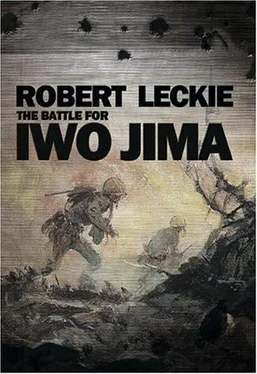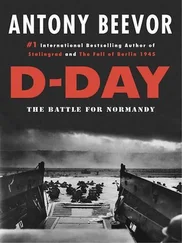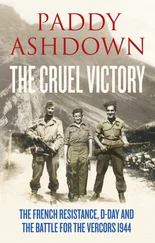Robert Leckie
THE BATTLE FOR IWO JIMA
To Angelo Bertelli and Douglas Boyd
Two Good Marines Who Fought at Iwo Jima
Chapter 1
THE MARINES GO IN
On February 19, 1945, the United States brought the war in the Pacific to the front doorstep of Japan. Iwo Jima was a tiny dark island four and a half miles long and two and a half miles wide. Located only 660 miles south of Tokyo, it looked from the air like a lopsided, black pork chop.
On the bright, clear morning of that fateful Monday, a vast armada of 485 American ships completely surrounded Iwo Jima. Battleships and cruisers stood off in the distance to batter Japanese positions and pin down the enemy so that the assault troops might get safely ashore. Great flashes of orange flame erupted from the ships’ guns as they sent huge shells howling toward their targets. Closer still, graceful destroyers seemed to dance off shore, dueling Japanese gun batteries, while rocket ships turned broadside to unleash flights of missiles.
Out of sight were the aircraft carriers, from whose decks had come the bombers and fighters that were also striking at Iwo. The planes flashed in and out of clouds of smoke and dust with bombs, rockets and machine guns. In addition, a formation of Liberators had flown in from faraway bases in the Marianas to make the little island quiver and shake with “carpets” of big bombs.
It did not seem possible that anything—especially human beings—could survive on little Iwo. And indeed there was no answering fire from the tiny dark island. All was strangely quiet. To the south, the volcano Mount Suribachi rose 550 feet above the sea. Just north of it, on the island’s east coast, were the landing beaches: silent, black and sinister. Then fading away to the north was a jumble of ridges rising to a high plateau. This was Iwo Jima, or Sulphur Island, which 70,000 United States Marines had come to claim for the Stars and Stripes.
As the aerial bombardment slackened, the first waves of Marines prepared to attack. Holding their rifles and machine guns, their flame throwers and bazookas, they filed down to the bottom deck of their landing ships. There they clambered aboard amphibious tractors, or “amtracks.” The amtracks, which the Japanese called “little boats with wheels” because of the gears on which their tracks turned, could churn through water and roll over land. Like great jaws, the forward bow doors of the landing ships yawned and opened wide. There was a great coughing and a roar of motors starting. Inside the landing ships the air became blue with smoke. Some of the Marines had begun to sweat, even though the air was crisp and cool. As they brushed aside beads of perspiration, they smeared the antiflash cream they had put on their faces to prevent burns.
Then the amtracks waddled forward. Like so many ducks, they spilled out of their mother ships, dropped into the water and formed landing circles. Around and around they circled, waiting for the order to attack. The order came. One by one the amtracks swung wide into the attack line. Gradually gathering speed, they went churning toward Iwo’s terraced beaches. The sea bombardment was lifting; the last aerial strike had come and gone. The sound of the amtrack motors was rising to a roar. Marines crouched anxiously below the gunwales, braced for the enemy’s long-awaited answering fire. None came.
Beneath them, the Marines felt a jolt and a lurch. Then they were on their feet—weapons held high—vaulting over the side and sinking ankle-deep into the warm, black sands of Iwo Jima.
Chapter 2
THE IMPORTANCE OF IWO
In the fall of 1944, the American high command had decided to capture Iwo Jima. The little island was important because it was only 660 miles from Tokyo. Iwo and the bigger island of Okinawa were to be used as bases for the final invasion of Japan.
But after the big B-29 Superfort bombers began to raid Japan from the recently captured chain of islands called the Marianas, the Americans realized that it was imperative to capture Iwo Jima as soon as possible. For Iwo lay on a direct line between the Marianas and Japan, and the Japanese on the island could give advance warning of the bombers’ approach. The enemy would then put up massive antiaircraft barrages and “stack” fighter planes high in the sky, waiting to pounce on the B-29s. If the fighters could not shoot down a B-29, then they tried to ram it. As a result, the Americans were losing far too many Superforts over Japan. Others were so crippled by the attacks that they crashed into the sea during the long 1500-mile trip back to the Marianas.
The American commanders saw at once that if they captured Iwo their bombers could fly closer to Japan without being detected. Next, Iwo would give them a base for fighter planes, which could then escort the bombers to and from Japan. Finally, and most important, Iwo Jima would be an ideal halfway-haven for crippled B-29s trying to limp back to base. By landing on Iwo’s emergency fields, they could be saved, along with their priceless crews. If they crashed between Japan and Iwo, or between Iwo and the Marianas, then at least the crews might be saved. Moreover, if Iwo became a regular stop-off on return flights, the bombers could carry less gasoline and more bombs.
These were the advantages of capturing Iwo Jima. Not only were they great, but they could be realized almost immediately. This does not happen often in war. Usually, an objective has long-range benefits.
The invasion of this little dot of land would also strike a blow at the enemy second only to the invasion of Japan itself. For Iwo Jima was Japanese soil. No foreigner had been known to set foot on it. All the other islands held by the Japanese had once belonged to some other country. For example, Tarawa had been a British colony and the Philippines had been an American territory. But Iwo Jima was part of the Prefecture of Tokyo, one of Japan’s 47 provinces. That was why the emperor had sent his best soldiers and one of his best generals out to defend it.
Lieutenant General Tadamichi Kuribayashi was a moon-faced, pudgy man who was fond of animals and children. He was also a stern soldier. His round belly, as one Japanese newspaper observed, was “packed full of very strong fighting spirit.” Kuribayashi had served in the cavalry, the elite of the Japanese army. He had fought with distinction in China before returning home to Tokyo. There, in May of 1944, he was summoned into the august presence of Premier Hideki Tojo and informed that he was to command at Iwo Jima. “Only you among all the generals are qualified and capable of holding this post,” Tojo said. “The entire army and the nation will depend on you for the defense of that key position.”
General Kuribayashi replied that he was honored to be chosen. Then, in the formal Japanese way, he bowed solemnly and left to say good-by to his wife and children. He did not tell them what he believed in his heart: that he would not return from Iwo Jima. But he did write to his brother: “I may not return alive from this assignment, but let me assure you that I shall fight to the best of my ability, so that no disgrace will be brought upon our family.”
General Kuribayashi’s conviction of a fight to the death became stronger after the Marianas fell. These island outposts were often called the Pearl Harbor of Japan. Their loss during July and August of 1944 so shocked the nation that Premier Tojo had to resign. Tojo had always told the emperor and the people that the Americans were soft and would not have the courage to fight a long and costly war. They would quickly give up, he said, and agree to a peace that would leave Japan in possession of most of her stolen empire. But the course of the war had taken a different turn. Now, two and a half years after the Japanese sneak attack on Pearl Harbor, the “soft” Yankees stood triumphant in the Marianas—only 1,500 miles from Japan! As Tojo knew, they would soon be using their B-29 bombers to raid the homeland itself, and because he failed to prevent this threat he had to step down.
Читать дальше











